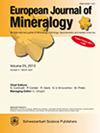与瓜伊马斯盆地岩浆岩柱侵入有关的接触变质反应和流体-岩石相互作用
IF 1.7
3区 地球科学
Q2 MINERALOGY
引用次数: 0
摘要
摘要。火成玄武岩侵入富含有机质的年轻沉积盆地不仅对碳循环有重大影响,而且对主要和微量元素在深层和表层地质储层之间的转移也有重大影响。国际大洋发现计划在第 385 次探险期间钻探的加利福尼亚湾瓜伊马斯海盆(Guaymas Basin)处于断裂活跃期,代表了一个海洋的新生阶段,其特征是富含硅质有机沉积物(硅藻泥)被非常密集的玄武岩山体网络侵入。这项研究的重点是 U1546 号地点,那里相对较高的地热梯度(超过 200 ∘C km-1)诱发了孔隙水和沉积物的早期成岩转变,涉及硫化物、碳酸盐和二氧化硅。对岩柱接触处沉积物进行的地球化学和矿物学分析表明,硫化物和二氧化硅多晶体是受接触变质作用影响的主要物相,分别从蛋白石-碳化钛转变为石英和黄铁矿转变为黄铁矿。质量平衡计算被用来估算变质岩浆孔中的质量转移。在顶部接触金刚岩中,主要的等化学变质作用体现在自生石英和 20-50 微米大小的黄铁矿晶体的存在,这些晶体填充了原生间隙空间,并且部分溶解了长石颗粒。在底部接触孔中,出现了石英和八面体黄铁矿晶体,它们比顶部接触孔中的晶体大 4 倍。在下部接触网中,沉积物发生了显著的变质作用,斜长石在长石周围发生重结晶,碳酸盐胶结斑块中局部出现了八面体辉石;这表明富碳流体在温度(T)高于 300 ∘C时析出。与上部接触层相比,下部接触层的氧化钙、氧化钠、氧化铁和微量元素(铜、砷、锌等)含量更高。根据这些岩石学研究,提出了岩浆-沉积物-流体相互作用的概念模型,将上接触过程和下接触过程区分开来。岩浆喷出引起的初始接触变质作用的特点是沉积物脱水反应和新矿物的结晶。随后,从释放的流体中析出碳酸盐。在最后阶段,温度随地热梯度重新平衡,岩石被热液进一步改变。本文章由计算机程序翻译,如有差异,请以英文原文为准。
Contact metamorphic reactions and fluid–rock interactions related to magmatic sill intrusion in the Guaymas Basin
Abstract. Igneous basaltic intrusions into young organic-rich sedimentary basins have a major impact not only on the carbon cycle but also on major and trace element transfers between deep and superficial geological reservoirs. The actively rifting Guaymas Basin in the Gulf of California, which was drilled by the International Ocean Discovery Program during Expedition 385, represents the nascent stage of an ocean characterized by siliceous organic-rich sediments (diatom ooze) intruded by a very dense network of basaltic sills. This study focuses on Site U1546 where the relatively high geothermal gradient (over 200 ∘C km−1) induces early diagenetic transformations in both pore waters and sediments, involving sulfide, carbonate and silica. Geochemical and mineralogical characterizations of the sediment at sill contacts indicate that sulfides and silica polymorphs are the main phases impacted by contact metamorphism, being evident by a transition from opal-CT to quartz and pyrite to pyrrhotite, respectively. Mass balance calculations have been used to estimate mass transfers in metamorphic aureoles. In the top contact aureole, predominantly isochemical metamorphism is reflected by the presence of authigenic quartz and disseminated 20–50 µm sized pyrrhotite crystals, filling primary interstitial space, and partial dissolution of detrital feldspar grains. In the bottom contact aureole, quartz and euhedral pyrrhotite crystals occur, which are up to 4 times larger than those at the top contact. Significant metamorphism of sediments is observed in the lower contact aureole, where plagioclase recrystallizes around the detrital feldspars and locally euhedral pyroxenes are included in patches of carbonate cement; this suggests precipitation from carbon-rich fluids at temperatures (T) higher than 300 ∘C. The lower contact aureole also is more enriched in CaO, Na2O, Fe2O3 and trace elements (Cu, As, Zn, etc.) compared to the upper contact. Based on these petrological investigations, a conceptual model of magma–sediment–fluid interaction is proposed distinguishing top and bottom contact processes. Initial contact metamorphism due to sill emplacement is characterized by dehydration reactions in sediments and crystallization of new minerals. It was followed by carbonate precipitation from the released fluids. At a final stage, the temperature re-equilibrated with the geothermal gradient and the rocks were further altered by hydrothermal fluids.
求助全文
通过发布文献求助,成功后即可免费获取论文全文。
去求助
来源期刊
CiteScore
2.80
自引率
9.50%
发文量
40
审稿时长
6-12 weeks
期刊介绍:
EJM was founded to reach a large audience on an international scale and also for achieving closer cooperation of European countries in the publication of scientific results. The founding societies have set themselves the task of publishing a journal of the highest standard open to all scientists performing mineralogical research in the widest sense of the term, all over the world. Contributions will therefore be published primarily in English.
EJM publishes original papers, review articles and letters dealing with the mineralogical sciences s.l., primarily mineralogy, petrology, geochemistry, crystallography and ore deposits, but also biomineralogy, environmental, applied and technical mineralogy. Nevertheless, papers in any related field, including cultural heritage, will be considered.

 求助内容:
求助内容: 应助结果提醒方式:
应助结果提醒方式:


